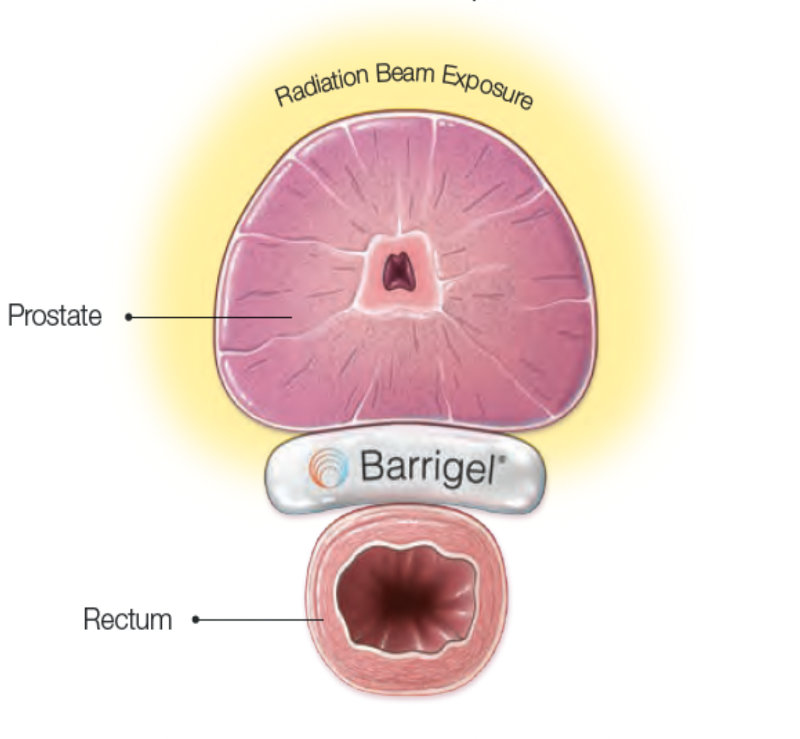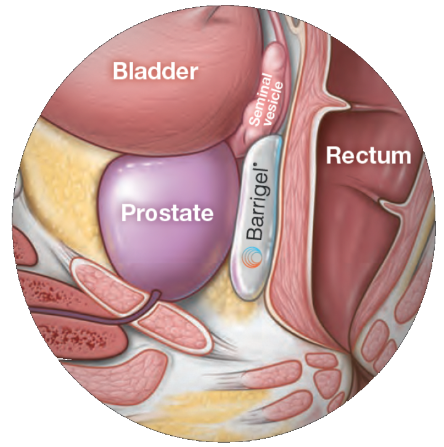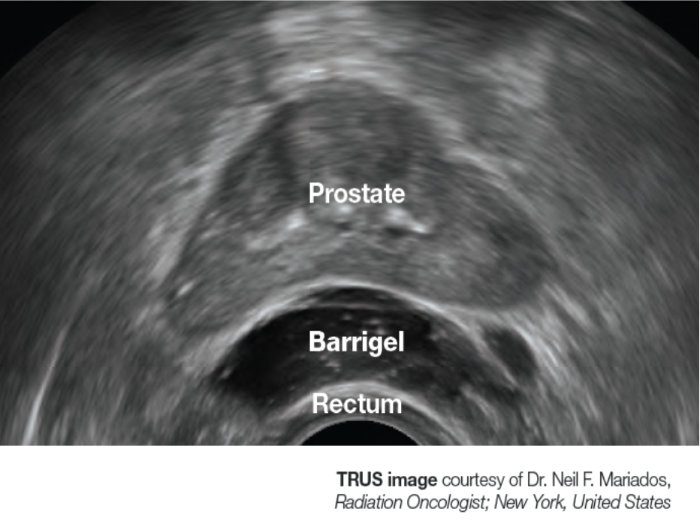Barrigel
What is Rectal Spacing?
Radiation therapy uses energy beams to destroy and stop the spread of cancer cells. These high energy beams can negatively affect healthy tissue surrounding the prostate.
Barrigel rectal spacer can help minimize prostate radiation side effects by temporarily positioning the rectum away from the prostate.

Barrigel creates space between the prostate and the rectum, moving the healthy organ out of the radiation beam exposure.

The Procedure
- Spacing procedures are performed in hospitals, outpatient clinics or doctors’ offices prior to the start of radiation treatment.
- Barrigel may be implanted at the same time as fiducial markers – small markers placed in your prostate to help your treatment team line up the radiation beams.
- Your doctor will use a medical imaging device called transrectal ultrasound (TRUS) to view your anatomy and place the spacer between your rectum and your prostate.
- The procedure is typically performed in under an hour.
- Most patients continue with normal daily activities shortly after the procedure, although your doctor may ask you to refrain from heavy lifting and strenuous physical activity for a few days.
- It is important to adhere to all of your doctor’s pre-procedure preparation and post-procedure instructions.
THE BARRIGEL DIFFERENCE
More personalized coverage for more complete protection
In rectal spacing, achieving even, complete coverage of healthy tissue is critical. This provides the most protection against radiation exposure.
Barrigel is the first and only rectal spacer that can be sculpted and shaped by your doctor to create a custom fit to your anatomy.

The seminal vesicles, which produce seminal fluid, are often exposed to radiation when treating prostate cancer. Protecting the rectum from seminal vesicle radiation exposure can help further reduce potential side effects.
VISUALLY-GUIDED SPACING
Barrigel is the only spacer that can be viewed clearly on transrectal ultrasound (TRUS), the imaging machine used to guide your doctor’s placement during the procedure. This added visibility provides your doctor even greater control and precision over the shape and positioning of the spacer.

STAYING POWER
Barrigel remains in place throughout the course of your radiation treatment, maintaining the space between your prostate and rectum until it is safely and fully absorbed by your body.
FREQUENTLY ASKED QUESTIONS
What is Barrigel made of and is it safe?
Barrigel is the first and only hyaluronic acid rectal spacer on the market. Barrigel is made from Non-Animal Stabilized Hyaluronic Acid, known as NASHA. NASHA has a long history of safety, efficacy and biocompatibility in a wide variety of medical applications, including pediatric medicine.
What are the risks associated with Barrigel?
As with any injection procedure, there is a risk of infection. Potential procedure-related side effects can include pain at the injection site and a brief period of bleeding from the needle stick. Post-treatment side effects include a mild to moderate sensation of rectal filling. Talk to your doctor about the risks associated with Barrigel.
How is the procedure performed?
Barrigel is placed between the rectum and the prostate through the perineum. Your doctor will use imaging technology called transrectal ultrasound (TRUS) during the procedure to sculpt the Barrigel spacer to your anatomy.
Where is the procedure done?
The Barrigel procedure is usually performed in a hospital or outpatient clinic prior to the start of radiation treatment. Barrigel may be inserted at the same time as fiducial marker placement.
How long before I can get back to regular activities following the procedure?
Most patients continue with normal daily activities shortly after the procedure, although your doctor may ask you to refrain from heavy lifting and strenuous physical activity for a few days.
How long will Barrigel remain in my body?
Barrigel is a hyaluronic acid that is biocompatible with your body. The spacer will stay in place for the duration of your radiation therapy and begin to safely reabsorb into your body after 3 months. It is important to note that Barrigel may be detected during anorectal examinations and medical imaging of the pelvis. You will receive a Barrigel Patient Implant Card following your procedure, which shows how Barrigel may be visible on medical imaging systems. It’s recommended that you keep this card for your records and inform your future doctors that you have had treatment with Barrigel.
Which types of radiation therapy can Barrigel be used with?
Barrigel can be used with all forms of radiation therapy when treating T1–T3b prostate cancer.* Talk with your doctor to find out if Barrigel is right for you.
